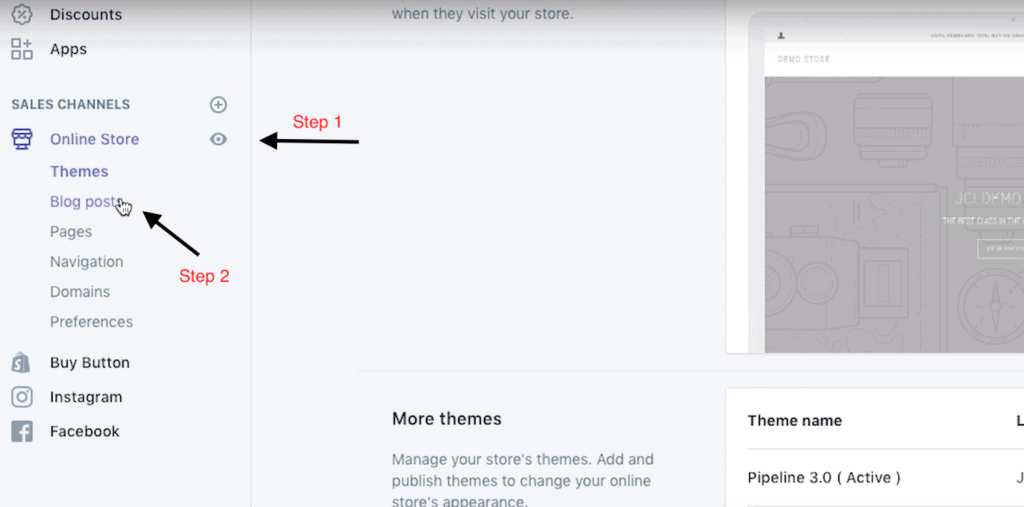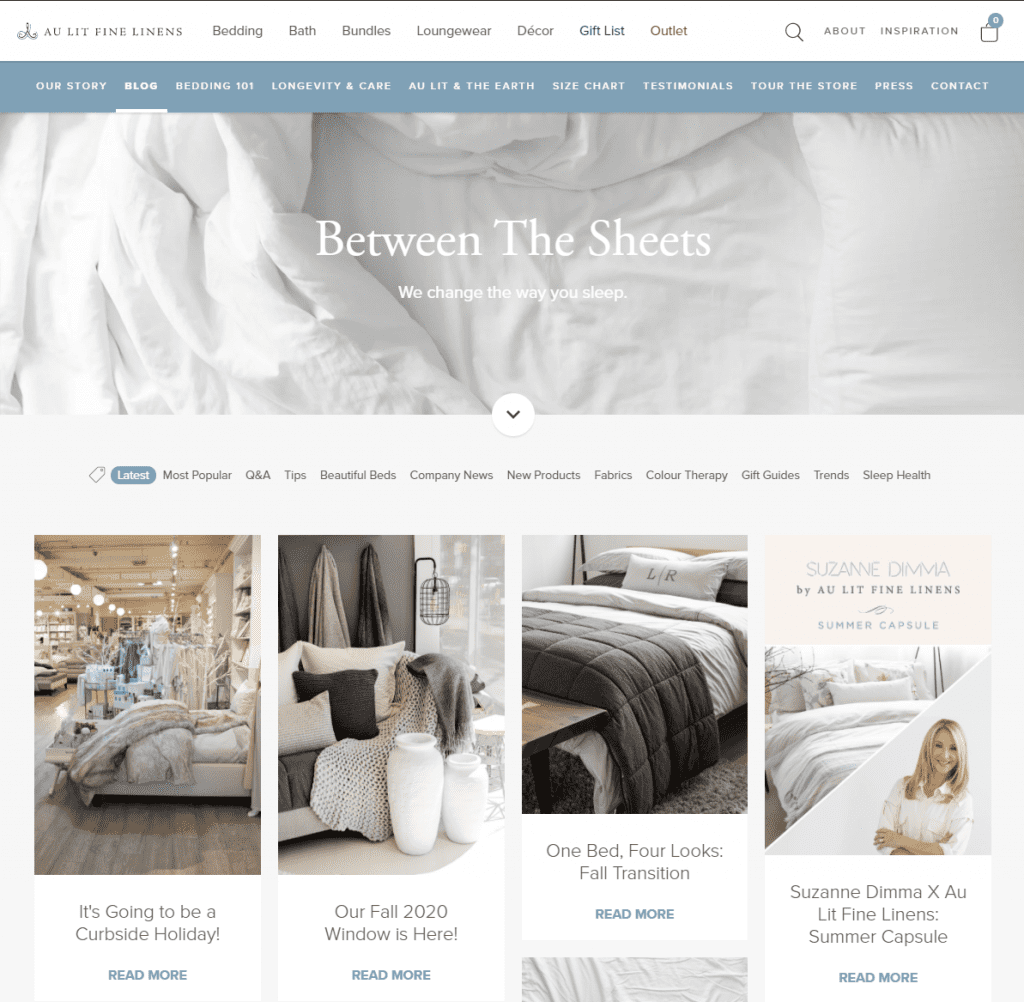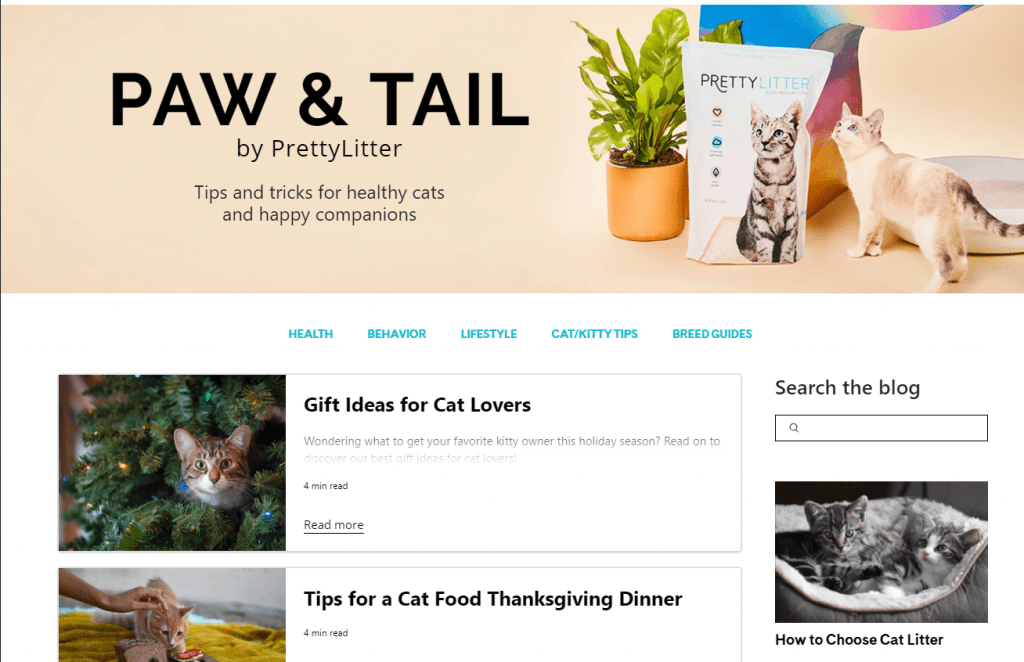
How To Start a Blog on Shopify (and 5 Blog Examples)

Does your business run on Shopify? This powerful suite of e-commerce tools generates an estimated $20 million in revenue each and every month, thanks to its robust and intuitive small business offerings.
Whether you’re already attuned to the wonders of Shopify or you’re still seeking a platform for your growing endeavor, knowing how to start a blog on Shopify can help you harness the power of content marketing to get noticed and build authority among your audience.
Follow these steps to add a blog to your Shopify store, then gather inspiration from five awesome examples of Shopify blogs done right.
First, Why Start a Blog on Shopify?
Content marketing helps attract new readers and guide them through your sales funnel, turning idle visitors into leads and then into customers. By publishing regular blog content on your Shopify site, you improve SEO performance, boosting your Google ranking and putting your store in front of fresh eyes.

At the same time, your targeted content will solve reader problems, fostering a sense of trust in your brand that helps them feel connected to you. Because this type of blog takes advantage of your organic Shopify content, you’ll get healthy, sustainable traffic that will help your company thrive. If you’re intrigued, this guide provides everything you need to know about launching your Shopify blog.
While many Shopify sites sell physical products, you can also sell services through this platform. Examples of thriving Shopify service sites include rentals, lessons, classes, tours, ticketed experiences, memberships, consultations and even digital products like ebooks, templates and other downloads.
How To Start a Blog on Shopify
Ready to set up a blog on Shopify? With consistent effort and quality content, your blog can flourish. Keep in mind that there are many things you can do to improve traffic, such as using strategic keywords and adding images. Using blog content services can also help you publish more quality content.
But since you’re here, we’ll show you how to get started.
1. Set Up Your Blog
First, log in to your Shopify Admin Account. This gives you access to the backend of Shopify, where you can change designs, write content and add features to your website.
Next, check out the right column and click on Online Store > Blog Posts. From here, click on Add blog post.

Now, you can create a blog post. Similar to WordPress, this template will allow you to add a creative title, content with formatting options and a featured image. Notice that on the far right, you can choose when to publish the blog and how to categorize. Shopify has an automatic “news” section that you can classify your blog as, or you can choose others. Tags can be a helpful way to categorize your blog.
2. Set Goals for Your Blog Content
Because your blog can help generate sales and increase traffic, it’s important to create a content strategy. Not only will an organized content plan help you direct your writing efforts effectively, but it also streamlines the writing process. If you know what you’re going to write about and how to write good blog posts, you don’t have to spend as much time worrying, researching and brainstorming.

Start simple by setting a few goals for your Shopify blog. For example, maybe you want to increase your new monthly leads by 300% or double your sales in the next quarter. Your content should support the goals you set, which should ideally be specific, measurable, achievable, relevant and time-bound (SMART).
Because you can tag your blog posts, this gives you categories that help readers find the blogs they want to read. Consider what main types of content you’ll produce. For example, if you own a baking business, you may want an entire category devoted to recipes. If you sell guitars, a third of your blog content could be guitar-playing tips. Tag your content so that readers can find a large selection of similar blog posts that address their needs.
However, try not to have too many tags, or it can get confusing. Many Shopify blogs stick to 1-2 overarching tags that help readers find what they’re looking for. Additionally, keep the tag names simple for ease of access.
3. Start Creating Blog Content
When you have your Shopify blog in place, creating content is as easy as visiting the Blog posts menu and clicking the Create blog post button. From there, you can add text, images, videos and links. You can also select an excerpt from the post to entice readers to click through and integrate tools to help search engines index and rank the post.

If you prefer to use an external service or your business already has a blog, you don’t need to use the site’s blogging software to know how to start a blog on Shopify successfully. You can also add a link to your existing blog on a service like Blogger or WordPress. Visit the Navigation area of your Shopify admin page to create a link to your blog on your main store page or within your navigation menu. Then, select the appropriate menu and click Add Menu Item to make a link for your blog. Save your work and you’re ready to connect with your readers!
SEO Tips for Your Shopify Blog
Blogs are a great way to direct traffic to your website, but only if they are optimized correctly. SEO plays a huge factor in helping a blog post be seen by interested readers. Here are a few SEO tips you can implement as you create each blog post:
- Avoid using H1s within the body of the text. Headings are used to create a hierarchy within the blog post, which improves the readability of your content. Headings also help search engines know what the most important parts of your blog post are. H1s should only be used for the title of your blog post.
- Use paragraphs, bullet points and white space. Help readers follow along by breaking up the text. Formatting your text in this way also improves SEO.
- Add images. You might see a pattern emerging; search engine optimization works hand in hand with reader optimization. Pictures can break up the text and make it more interesting for readers while also improving SEO.
As you combine readability, formatting and high-quality content, you will increase both your search engine rankings and overall readership.
4. Build a Shopify Post Calendar
Maybe you already have a notebook bursting with blog ideas for your business. If you haven’t been brainstorming topics, now’s the time to plan content that will paint your brand and your products in the best possible light. When learning how to start a blog on Shopify, consider writing (or hire a blog service to write) posts that:
- Cover the design and manufacturing process for your product.
- Showcase the faces behind your brand.
- Illustrate various uses of the product and highlight fans of your brand with case studies.
- Show potential buyers how to use your product.
- Describe pain points that your product can solve.
Remember that you can also publish posts that aren’t directly related to your products. Evergreen articles about your industry and topics related to your brand improve your SEO rankings while cementing your place as an expert in the minds and hearts of your audience. Regardless of the topic, however, each piece of content you publish on your blog should directly tie back to one of your established content marketing goals.
Once you have your list of post ideas in place, schedule them on a calendar to keep your editorial plan on track. While you can adjust posting frequency and schedule based on your needs and preferences, most businesses publish weekly or twice-weekly posts once they understand how to start a blog on Shopify.
5. Develop Your Blog Content
Whether you plan to hire a blog service or rely on a staff writer, draft a thorough content brief for each planned post. This should include details about the topics, desired links, SEO keywords, length, and ancillary items such as photos or metadata.

As you decide how to develop each content asset, don’t forget to thoroughly audit your existing publications. You can reduce, reuse and recycle in a variety of ways, such as:
- Breaking longer blog posts into bite-size social media teasers
- Updating and republishing outdated items
- Pulling together several related posts into a long-form blog, whitepaper or ebook
- Changing the format of a content asset, such as developing an infographic from an old blog
- Curating guest posts from other content creators within your niche, especially those with whom you’d like to build a partnership.
If content writing seems overwhelming, don’t discount the benefits of building a blog for your brand. Instead, look into outsourcing content to take advantage of the expertise and convenience of a professional blog service. You’ll have access to the resources of a full-service content shop without the cost of hiring an in-house writer or the stress of adding “blog writer” to your long list of roles.
6. Attract Readers to Your Shopify Blog
Learning how to start a blog on Shopify won’t have much impact on your business without a comprehensive promotion plan. Spread the word about your brand-new blog on all your business’s social media platforms, including but not limited to Pinterest, Twitter, Instagram, Facebook and LinkedIn. If you publish an email newsletter, make sure to announce your new content outlet to your dedicated subscribers.

You can also connect with potential new customers on the places where they hang out online. Look for message boards dedicated to your niche area on forums such as Quora and Reddit.
7. Review Benchmarks for Success
Remember those goals you set when you started learning how to start a blog on Shopify? Pull them out at the end of the first month of blogging and see where you are with your progress. Consider the following questions:
- Am I achieving my SMART goals?
- Are these goals helping my brand and generating customers in the way I want?
- How can I refine/update my goals to better fit my needs?
Actively improving your content strategy will help you get the most success out of your Shopify blog. To see the results of blogging efforts, many blog publishers use tools like Google Analytics to gather information about visitor engagement, traffic and page views.
Need Great Blog Posts for Your Shopify Store?
We specialize in creating original, engaging blog posts for your Shopify store at affordable prices. Check out our Shopify blog writing services.
5 Great Shopify Blog Examples
Don’t just take our word, Shopify blogs can be great assets to your website. Here are five great examples of effective Shopify blogs that engage readers and bring in more traffic:
1. Gaiam

If you’ve ever taken a yoga class or two, you’ve probably heard of Gaiam. This retailer specializes in high-quality yoga mats, apparel and accessories for a lifestyle centered on wellness.
Gaiam’s Shopify blog provides content to match, seamlessly tying into their merchandise with yoga how-tos for beginners and yoga education for special interest groups like swimmers, runners and seniors. These posts are interspersed with aspirational, lifestyle-based pieces about topics like living an authentic life and tapping into the benefits of meditation.
Gaiam’s mix of content drives SEO optimization and promotes conversion, all while positioning the company as a trusted authority in the yoga and wellness world. If you want to know how to start a blog on Shopify, this successful example is a great guide to look at.
2. Au Lit Fine Linens

You might not think that a blog about bedding could be compelling, the Shopify blog by this brand, is just that. Educational topics on the company’s Between the Sheets blog cover both sound sleep and sophisticated loungewear, gifts and home décor (notice the strategic tags that categorize blog posts). Readers will learn how to select and purchase sheets, duvets, quilts and related products while thinking about the quality of their sleep and the serenity of their space.
Like the content from Gaiam, the Au Lit Fine Linens blog provides problem-solving information with an aspirational quality. The soft colors and soothing tone of Between the Sheets appeal to clients who want to create a luxe sleeping space. The content here sells a lifestyle as well as a product line, with a diverse range of content types like tip lists, infographics and charts.
3. VineBox

The Shopify blog by this subscription wine service shows off a brand that truly knows its readership. Wine fans who already subscribe or might sign up for VineBox consider themselves connoisseurs, and the company’s content gives potential and current customers the knowledge they need to fill the role in real life.
Short, snappy content makes the sometimes-complex concepts behind wine accessible to readers, with fun facts about the flavor notes in different bottles, details about the history of grapes used to make wines and dinner-party pairings to impress guests. The VineBox blog acts as a mentor for those who fancy becoming solo sommeliers, using the wines they get in their subscription boxes of course. Even if you’re not a fan of wine, you can learn a lot about how to write intoxicating content for your blog on Shopify.
4. PrettyLitter

Who would want to read a blog about cat litter? No matter how potentially unappealing your product may seem from a content standpoint, the PrettyLitter Shopify blog sells its products effectively by serving as a one-stop-shop for cat owners. Visitors will find everything from how to choose a cat to fit their lifestyle to caring for an elderly pet, serving their readers by addressing common pet owner pain points. At the same time, this brand increases its SEO by ranking for industry keywords that might otherwise be the sole landscape of larger businesses.
5. Ridgewallet

The Ridge by Ridgewallet is a great combination of class and modern design. This company sells metal wallets that limit clutter, protect your credit cards and look great in your pocket. Many articles are focused on educating readers on the benefits of using a metal wallet and lifestyle tips.
The theme of this blog is professional, intelligent and simplistic. The combination of colors, images and persuasive content can be a great inspiration to you as you consider design elements for your blog.
Hire a Blog Service for Your Shopify Blog
Now that you know how to start a blog on Shopify and you’ve seen a few blog examples, you’ll need content that can cast your business in the best possible light. If you don’t have a writer on staff or the time to create your own content, consider hiring a blog service like the team at BKA Content.
We offer several solutions to streamline your content marketing efforts, including monthly blog subscriptions, self-serve content and managed services with a dedicated account representative to guide your strategy. Get in touch today to learn more about how BKA Content can take your new Shopify blog to the next level.
- How To Use Keywords in Your Content for SEO - May 20, 2024
- Creating Google-Friendly Content - December 31, 2023
- Which Type of Content Brings In the Most Traffic? - December 28, 2023

